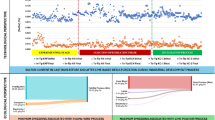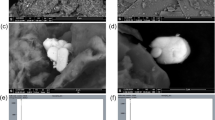Abstract
Solid process fine waste or tailings of a uranium mill is a potential source of release of radiologically significant gaseous radon (222Rn). A number of variables such as radium (226Ra) content, porosity, moisture content, and tailings density can affect the extent of emanation from the tailings. Further, if a cover material is used for remediation purposes, additional challenges due to changes in the matrix characteristics in predicting the radon flux can be anticipated. The uranium mill tailings impoundment systems at Jaduguda have been in use for the long-term storage of fine process waste (tailings). A pilot-scale remediation exercise of one of the tailings ponds has been undertaken with 30 cm soil as a cover material. For the prediction of the radon flux, a numerical model has been developed to account for the radon exhalation process at the remediated site. The model can effectively be used to accommodate both the continuous and discrete variable inputs. Depth profiling and physicochemical characterization for the remediated site have been done for the required input variables of the proposed numerical model. The predicted flux worked out is well below the reference level of 0.74 Bq m−2 s−1 IAEA (2004).




Similar content being viewed by others
Data availability
All data produced and analyzed in this study are included in the article.
References
Ballini M, Chautard C, Nos J, Phrommavanh V, Beaucaire C, Besancon C, Boizard A, Cathelineau M, Peiffert C, Vercouter T, Vors E (2020) A multi-scalar study of the long-term reactivity of uranium mill tailings from Bellezane site (France). J Environ Radioact 218:106223. https://doi.org/10.1016/j.jenvrad.2020.106223
Charles M (2001) UNSCEAR Report 2000: sources and effects of ionizing radiation. J Radiol Prot 21(1):83–85. https://doi.org/10.1088/0952-4746/21/1/609
Chautard C, Beaucaire C, Gerard M, Roy R, Savoye S, Descostes M (2020) Geochemical characterization of uranium mill tailings (Bois Noirs Limouzat, France) highlighting the U and 226Ra retention. J Environ Radioact 218:106251. https://doi.org/10.1016/j.jenvrad.2020.106251
Dai X, Chen Y, Chen Y, Wang H, Li X, Hong C, Liu Y (2021) Effect of thickness and compaction degree of overburden soil on radon reduction for uranium tailings reservoir. Science and Technology of Nuclear Installations, 2021. https://doi.org/10.1155/2021/9984939
Dunn JA, Dey AK (1942) Geology and petrology of eastern Singhbhum and surrounding areas. Mem Geolo Surv, India 69(2):1942. https://doi.org/10.4236/jwarp.2010.27079
Field RW (2019) Radon: an overview of health effects. Encycl Environ, 467–475. https://doi.org/10.1016/B978-0-12-409548-9.09545-2
Fuhrmann M, Benson CH, Likos WJ, Stefani N, Michaud A, Waugh WJ, Williams MM (2021) Radon fluxes at four uranium mill tailings disposal sites after about 20 years of service. J Environ Radioact 237:106719. https://doi.org/10.1016/j.jenvrad.2021.106719
Gosh T, Maity PP, Das TK, Krishnan PRAMEELA, Bhatia ARTI, Bhattacharya P, Sharma DK (2020) Variation of porosity, pore size distribution and soil physical properties under conservation agriculture. Indian J Agric Sci 90:2051–2058
Gupta R, Sarangi AK (2005) Emerging trend of uranium mining: the Indian scenario. In: IAEA symposium on uranium production and raw materials for the nuclear fuel cycle-supply and demand, economics, the environment and energy security. Vienna pp 47–56. https://ucil.gov.in/pdf/myth/Emerging%20trend%20in%20U%20mining.pdf. Accessed 7 Mar 2024
IAEA (2004) The long term stabilization of uranium mill tailings. https://www-pub.iaea.org/MTCD/Publications/PDF/te_1403_web.pdf Accessed 23 July 2022
Ishimori Y, Lange K, Martin P, Mayya YS, Phaneuf M (2013) Measurement and calculation of radon releases from NORM residues. IAEA: N. p., 2013. Web. https://www-pub.iaea.org/MTCD/Publications/PDF/trs474_webfile.pdf. Accessed 4 March 2023
Jha VN, Tripathi RM, Sethy NK, Sahoo SK, Shukla AK, Puranik VD (2010) Bioaccumulation of 226Ra by plants growing in fresh water ecosystem around the uranium industry at Jaduguda. India J Environ Radioact 101(9):717–722. https://doi.org/10.1016/j.jenvrad.2010.04.014
Kang JK, Seo S, Jin YW (2019) Health effects of radon exposure. Yonsei Med J 60(7):597–603
Khan SM, Chreim S (2019) Residents perceptions of radon health risks: a qualitative study. BMC Public Health 19(1):1–11. https://doi.org/10.1186/s12889-019-7449-y
Khan AH, Jha VN, Jha S, Kumar R, Basu SK (2002) Assessment of environmental impact of mining and processing of uranium ore at Jaduguda, India. https://www.osti.gov/etdeweb/biblio/20265806. Accessed 7 March 2024
Liu B, Sun H, Peng T, Duan T (2020) Transport and transformation of uranium and heavy metals from uranium tailings under simulated rain at different pH. Environ Chem Lett 18(2):495–503. https://doi.org/10.1007/s10311-019-00951-4
Machaj B, Bartak J (2004) Fast measurement of radon concentration in water with Lucas cell. Nukleonika 49(1):29–31
Maharana M, Eappen KP, Sengupta D (2010) Radon emanometric technique for 226 Ra estimation. J Radioanal Nucl Chem 285:469–474
Majhi T, Sarkar N (2019) Study on soil moisture variations in responding to tensiometer and soil moisture meter with respect to gravimetric method. Int J Chem Stud 7(4):3179
Mathur SR, Murthy JY (2018) Unstructured finite volume methods for multi-mode heat transfer. In: Advances in numerical heat transfer, vol 2. https://doi.org/10.1201/9781315136882
Mayer D W, Oster C A, Nelson R W, Gee G W (1981) Radon diffusion through multilayer earthen covers: models and simulations (No. PNL-3989). Battelle Pacific Northwest Labs., Richland, WA (USA). https://doi.org/10.2172/5767604
Nayak HP, Osuri KK, Sinha P, Nadimpalli R, Mohanty UC, Chen F, Rajeevan M, Niyogi D (2018) High-resolution gridded soil moisture and soil temperature datasets for the Indian monsoon region. Sci Data 5(1):1–17. https://doi.org/10.1038/sdata.2018.264
Ob WL, DeLand SM, Rutherford BM, Diegert KV, Alvin K F (2000) Estimation of total uncertainty in modeling and simulation. Sandia Report SAND2000–0824, Albuquerque, NM, 56. https://cmapspublic3.ihmc.us/rid=1MHBP6C58-13RYBTH-16L9/Estimation%20of%20Total%20Uncertainty%20in%20Modeling%20and%20Simulation.pdf Accessed 10 April 2023
Papachristodoulou C, Ioannides K, Spathis S (2007) The effect of moisture content on radon diffusion through soil: assessment in laboratory and field experiments. Health Phys 92(3):257–264. https://doi.org/10.1097/01.HP.0000248147.46038.bc
Patra AC, Sumesh CG, Mohapatra S, Sahoo SK, Tripathi RM, Puranik VD (2011) Long-term leaching of uranium from different waste matrices. J Environ Manage 92(3):919–925. https://doi.org/10.1016/j.jenvman.2010.10.046
Rana D, Jha VN, Patnaik RL, Singh MK, Jha SK, Kulkarni MS (2023) Radon build-up in a prototype dwelling using uranium mill tailings as construction material. J Radioanal Nucl Chem. https://doi.org/10.1007/s10967-023-09001-4
Rogers VC, Nielson KK, Kalkwarf DR (1984) Radon attenuation handbook for uranium mill tailings cover design (No. NUREG/CR-3533; PNL-4878; RAE-18–5). Rogers and Associates Engineering Corp., Salt Lake City, UT (USA). https://doi.org/10.2172/6883619
Roxy MS, Sumithranand VB, Renuka G (2010) Variability of soil moisture and its relationship with surface albedo and soil thermal diffusivity at Astronomical Observatory, Thiruvananthapuram, south Kerala. J Earth Syst Sci 119(4):507–517. https://doi.org/10.1007/s12040-010-0038-1
Sabat L, Kundu CK (2020) History of finite element method: a review. Recent Dev Sustain Infrastruct: Select Proc ICRDSI 2019:395–404
Sadegh-Vaziri R, Winberg-Wang H, Babler MU (2021) 1D finite volume scheme for simulating gas–solid reactions in porous spherical particles with application to biomass pyrolysis. Ind Eng Chem Res 60(29):10603–10614. https://doi.org/10.1021/acs.iecr.1c00674
Saptaningtyas FY, Setyarsi AD (2018) Finite volume method with explicit scheme technique for solving heat equation. In Journal of Physics: Conference Series (Vol. 1097, No. 1, p. 012089). IOP Publishing. https://doi.org/10.1088/1742-6596/1097/1/012089
Sharma DB, Jha VN, Singh S, Sethy NK, Sahoo SK, Jha SK, Kulkarni MS (2021) Distribution of 210Pb and 210Po in ground water around uranium mineralized area of Jaduguda, Jharkhand, India. J Radioanal Nucl Chem 327(1):217–227. https://doi.org/10.1007/s10967-020-07495-w
Singh S, Jha VN, Sharma DB, Sethy NK, Rout S, Jha SK, Kulkarni MS (2022) Speciation and mobility of uranium in waste materials generated by mining and hydrometallurgy in Jaduguda, India. J Hazard, Toxic, Radioact Waste 26(2):04022007. https://doi.org/10.1061/(ASCE)HZ.2153-5515.0000673
Singh L, Soni P (2010) Concentration of radionuclides in uranium tailings and its uptake by plants at Jaduguda, Jharkhand, India. Curr Sci 37–49. http://www.indiaenvironmentportal.org.in/files/Concentration%20of%20radionuclides%20in%20uranium.pdf. Accessed 7 Mar 2024
Sobieski W, Trykozko A (2018) Discretisation of thermal diffusion equation in multilayer structures with variable material parameters and different thicknesses. J Appl Comput Sci 26(2):213–240
Tellinghuisen J (2001) Statistical error propagation. J Phys Chem A 105(15):3917–3921. https://doi.org/10.1021/jp003484u
USNRC REGULATORY GUIDES (1989) Calculation of radon flux attenuation by earthen uranium mill tailings covers. REGULATORY GUIDE 3.64 (Task WM 503–4) https://inis.iaea.org/collection/NCLCollectionStore/_Public/21/011/21011462.pdf?r=1 Accessed 03 March 2023
Verbeke J, Cools R (1995) The Newton-Raphson method. Int J Math Educ Sci Technol 26(2):177–193. https://doi.org/10.1080/0020739950260202
Waugh WJ (2004) Design, performance, and sustainability of engineered covers for uranium mill tailings (No. DOE/LM-Engineering-Covers). USDOE Office of Legacy Management (LM). https://doi.org/10.2172/1132788
Yin M, Sun J, Chen Y, Wang J, Shang J, Belshaw N, Chen D (2019) Mechanism of uranium release from uranium mill tailings under long-term exposure to simulated acid rain: geochemical evidence and environmental implication. Environ Pollut 244:174–181. https://doi.org/10.1016/j.envpol.2018.10.018
Acknowledgements
All the authors are grateful to Dr. D. K. Aswal, Director, HSEG, Bhabha Atomic Research Centre, Mumbai, for his precious direction, support, and scientific encouragement throughout the study. The priceless support from colleagues of Health Physic Unit Jaduguda is highly treasured.
Author information
Authors and Affiliations
Contributions
Dibyendu Rana—model development, experimental work, and manuscript drafting; Vivekanad Jha—manuscript drafting, statistical data analysis, and evaluation of basic soil parameters; RLokeswara Patnaik—field investigation, tailings characteristics, and other parameters; Manish Kumar Singh—field investigation, sampling, and tailings characteristics; Sanjay Kumar Jha—supervision, review, and manuscript finalization; Mukund S. Kulkarni—evaluation of scientific content, modification, editing, and resource management.
Corresponding author
Ethics declarations
Ethical approval
Not applicable.
Consent to participate
Not applicable.
Consent for publication
Not applicable.
Competing interests
The authors declare no competing interests.
Additional information
Responsible Editor: Georg Steinhauser
Publisher's Note
Springer Nature remains neutral with regard to jurisdictional claims in published maps and institutional affiliations.
Appendix
Appendix
Tri-diagonal matrix algorithm.
The tridiagonal matrix equation is:
Equation (27) can be written as:
where \(P\left(i\right)=-\frac{A(i)}{F(i)}\), \(Q\left(i\right)=-\frac{B(i)}{F(i)}\), and \(R\left(i\right)=-\frac{Co(i)}{F(i)}\) are the modified coefficients of the tri-diagonal matrix equation. For 1st node, Q(1) = 0 and Eq. (28) for 1st node can be written as:
Similarly for 2nd node:
Combining Eq. (28) and Eq. (29), one can obtain:

where \(\check{P}\left(2\right)=\frac{P(2)}{1-P\left(1\right)Q(1)}\) and \(\check{R}\left(2\right)=\frac{R\left(2\right)-R\left(1\right)Q(1)}{1-P\left(1\right)Q(1)}\). Repeating the same process in subsequent equations, the derived recurrence relations are written in Eqs. (31.1) and (31.2):


where \(\check{P}\left(1\right)={\text{P}}\left(1\right)\) and \(\check{R}\left(1\right)={\text{R}}\left(1\right)\). The modified form of Eq. (28) using Eqs. (31.1) and (31.2) is shown in Eq. (32).

For the Nth node, with \({C}_{a}\left(N+1\right)=0\), one can obtain \({C}_{a}\left(N\right)= \check{R}\left(N\right)\), and reverse substitution in Eq. (32) in the order i = N-1, N-2, ……0.1 will give radon concentration at each node. Flux at the boundary has been estimated using Eq. (33):
Rights and permissions
Springer Nature or its licensor (e.g. a society or other partner) holds exclusive rights to this article under a publishing agreement with the author(s) or other rightsholder(s); author self-archiving of the accepted manuscript version of this article is solely governed by the terms of such publishing agreement and applicable law.
About this article
Cite this article
Rana, D., Jha, V., Patnaik, R. et al. A numerical model for the prediction of radon flux from uranium mill tailings at Jaduguda, India. Environ Sci Pollut Res 31, 24951–24960 (2024). https://doi.org/10.1007/s11356-024-32674-7
Received:
Accepted:
Published:
Issue Date:
DOI: https://doi.org/10.1007/s11356-024-32674-7




